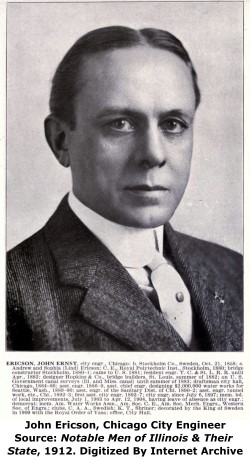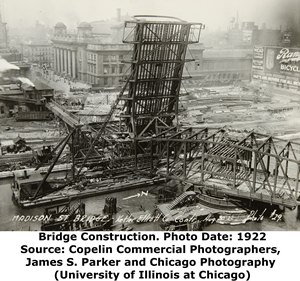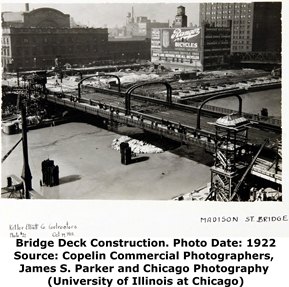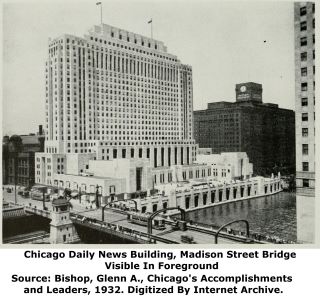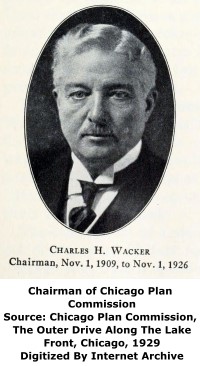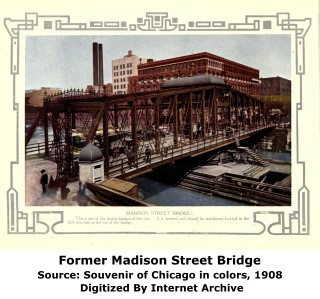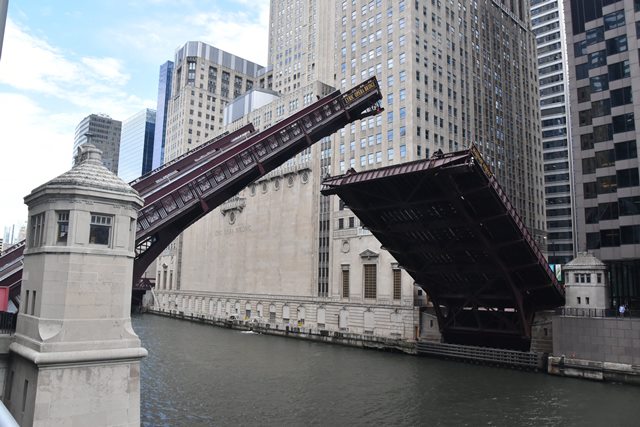We Recommend:
Bach Steel - Experts at historic truss bridge restoration.
BridgeHunter.com Phase 1 is released to the public! - Visit Now
Madison Street Bridge
Lyric Opera Bridge
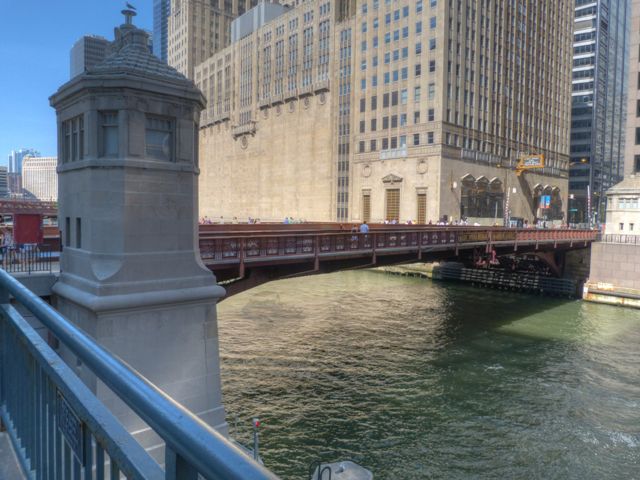
Primary Photographer(s): Nathan Holth
Bridge Documented: August 12, 2006 - October 7, 2017
Chicago: Cook County, Illinois: United States
Metal Rivet-Connected Pratt Railing Height Truss, Movable: Double Leaf Bascule (Fixed Trunnion) and Approach Spans: Metal Stringer (Multi-Beam), Fixed
1922 By Builder/Contractor: Ketler-Elliott Company of Chicago, Illinois and Engineer/Design: City of Chicago
1994
221.0 Feet (67.4 Meters)
283.2 Feet (86.3 Meters)
38 Feet (11.58 Meters)
1 Main Span(s) and 3 Approach Span(s)
16603427326

View Information About HSR Ratings
Bridge Documentation
View Archived National Bridge Inventory Report - Has Additional Details and Evaluation
View Historical Article About A Temporary Pedestrian Bridge Used During Construction of This Bridge

This bridge was the first bascule bridge in Chicago whose trusses are configured such that the bridge is partly a pony truss and partly a deck truss. In this innovative design, Chicago engineers positioned the truss so that part of the truss was above the deck which the top chord could also act as a railing to separate vehicular and pedestrian traffic. This gives rise to the descriptive name "railing-height truss." This design also increased the clearance under the bridge since the trusses do not extend so far below the deck. Finally, it also made the bridge look thinner and more streamlined, which was a goal planners and architects had for Chicago bridges.
This bridge stands out among the bridges of Chicago as one of the most historically and technologically significant since it is the first example of a design that Chicago would use in construction on many bridges during a period of over 40 years. It also retains ornate sidewalk railings that greatly contribute to the visual beauty of the bridge.
The first bridge at this location documented in Annual Reports of the Department of Public Works was an 1849 wooden bridge. The next known bridge built at this location dated to 1856-1857 and was the first bridge in Chicago built entirely with city funds. It was also listed as an iron bridge, making it one of the first iron bridges in the city. It was 155 feet long and the contractor was listed as "Gaylord." In 1875, the bridge was rebuilt as a steam powered iron swing bridge by the American Bridge Company of Chicago. In 1891, this bridge was moved to Washington Street and the bridge was again rebuilt, this time of steel by Ritner and Conley. This bridge was a pin-connected through truss center pier swing bridge. This type of bridge was once common in Chicago and nearly all swing bridges were replaced by bascule bridges to provide an opening without the obstruction of a pier in the center of the bridge. The Madison Street swing bridge, like a number of swing bridges once located in Chicago included ornate portal bracing and portal cresting. Aside from these enhancements, the bridge would have been considered utilitarian in appearance at the time it was constructed.
|
Main Plaque WM HALE THOMPSONMAYOR
HUGH E. YOUNG ENGINEER OF BRIDGE DESIGN CHICAGO PLAN COMMISSION E. H. BENNETT CONSULTING ARCHITECT CHICAGO CHAPTER OF AMERICAN INSTITUTE OF ARCHITECTS CHICAGO ART COMMISSION CONSTRUCTION
1922 |
Rehabilitation Plaque LYRIC OPERA BRIDGEMADISON STREET BRIDGE RECONSTRUCTION CITY OF CHICAGO DEPARTMENT OF TRANSPORTATION 1994 RICHARD M. DALEY MAYOR J. F. BOYLE, JR. COMMISSIONER S. L. KADERBEK CHIEF ENGINEER |
![]()
Historic Bridges of Chicago and Cook County


Chicago and Cook County are home to one of the largest collections of historic bridges in the country, and no other city in the world has more movable bridges. HistoricBridges.org is proud to offer the most extensive coverage of historic Chicago bridges on the Internet.
General Chicago / Cook County Bridge Resources
Chicago's Bridges - By Nathan Holth, author of HistoricBridges.org, this book provides a discussion of the history of Chicago's movable bridges, and includes a virtual tour discussing all movable bridges remaining in Chicago today. Despite this broad coverage, the book is presented in a compact format that is easy to take with you and carry around for reference on a visit to Chicago. The book includes dozens of full color photos. Only $9.95 U.S! ($11.95 Canadian). Order Now Direct From The Publisher! or order on Amazon.
Chicago River Bridges - By Patrick T. McBriarty, this is a great companion to Holth's book shown above. This much larger book offers an extremely in-depth exploration of Chicago's movable highway bridges, including many crossings that have not existed for many years. Order Now Direct From The Publisher! or order on Amazon.
View Historic American Engineering Record (HAER) Overview of Chicago Bascule Bridges (HAER Data Pages, PDF)
Chicago Loop Bridges - Chicago Loop Bridges is another website on the Internet that is a great companion to the HistoricBridges.org coverage of the 18 movable bridges within the Chicago Loop. This website includes additional information such as connections to popular culture, overview discussions and essays about Chicago's movable bridges, additional videos, and current news and events relating to the bridges.
Additional Online Articles and Resources - This page is a large gathering of interesting articles and resources that HistoricBridges.org has uncovered during research, but which were not specific to a particular bridge listing.
This bridge is tagged with the following special condition(s): Unorganized Photos
![]()
Photo Galleries and Videos: Madison Street Bridge
Bridge Photo-Documentation
Original / Full Size PhotosA collection of overview and detail photos. This gallery offers photos in the highest available resolution and file size in a touch-friendly popup viewer.
Alternatively, Browse Without Using Viewer
![]()
Bridge Photo-Documentation
Mobile Optimized PhotosA collection of overview and detail photos. This gallery features data-friendly, fast-loading photos in a touch-friendly popup viewer.
Alternatively, Browse Without Using Viewer
![]()
Additional Unorganized Photos
Original / Full Size PhotosA supplemental collection of photos that are from additional visit(s) to the bridge and have not been organized or captioned. This gallery offers photos in the highest available resolution and file size in a touch-friendly popup viewer.
Alternatively, Browse Without Using Viewer
![]()
Additional Unorganized Photos
Mobile Optimized PhotosA supplemental collection of photos that are from additional visit(s) to the bridge and have not been organized or captioned. This gallery features data-friendly, fast-loading photos in a touch-friendly popup viewer.
Alternatively, Browse Without Using Viewer
![]()
Raising Leaf, Elevation
Full Motion VideoTaken June 2011. Streaming video of the bridge. Also includes a higher quality downloadable video for greater clarity or offline viewing.
![]()
Bridge Being Raised, Portal View
Full Motion VideoNote: The downloadable high quality version of this video (available on the video page) is well worth the download since it offers excellent 1080 HD detail and is vastly more impressive than the compressed streaming video. Streaming video of the bridge. Also includes a higher quality downloadable video for greater clarity or offline viewing.
![]()
Maps and Links: Madison Street Bridge
Coordinates (Latitude, Longitude):
Search For Additional Bridge Listings:
Bridgehunter.com: View listed bridges within 0.5 miles (0.8 kilometers) of this bridge.
Bridgehunter.com: View listed bridges within 10 miles (16 kilometers) of this bridge.
Additional Maps:
Google Streetview (If Available)
GeoHack (Additional Links and Coordinates)
Apple Maps (Via DuckDuckGo Search)
Apple Maps (Apple devices only)
Android: Open Location In Your Map or GPS App
Flickr Gallery (Find Nearby Photos)
Wikimedia Commons (Find Nearby Photos)
Directions Via Sygic For Android
Directions Via Sygic For iOS and Android Dolphin Browser
USGS National Map (United States Only)
Historical USGS Topo Maps (United States Only)
Historic Aerials (United States Only)
CalTopo Maps (United States Only)


